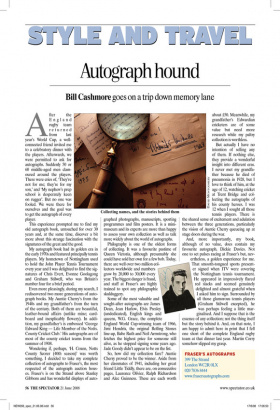Autograph hound
Bill Cashmore goes on a trip down memory lane After the England rugby team returned from last year’s World Cup, a wellconnected friend invited me to a celebratory dinner with the players. Afterwards, we were permitted to ask for autographs. Suddenly 50 or 60 middle-aged men clamoured around the players. There were cries of, ‘They’re not for me; they’re for my son,’ and ‘My nephew’s prep school is desperately keen on rugger’. But no one was fooled. We were there for ourselves and the goal was to get the autograph of every player.
This experience prompted me to find my old autograph book, untouched for over 30 years and, at the same time, discover a bit more about this strange fascination with the signatures of the great and the good.
My autograph book had its golden era in the early 1970s and featured principally tennis players. My hometown of Nottingham used to hold the John Player Tennis Tournament every year and I was delighted to find the signatures of Chris Evert, Evonne Goolagong and Graham Stilwell, who was Britain’s number four for a brief period.
Even more pleasingly, during my search, I rediscovered two more generations of autograph books. My Auntie Cherry’s from the 1940s and my grandfather’s from the turn of the century. Both of them are beautiful, leather-bound affairs (unlike mine; cardboard and inexplicably flowery). In addition, my grandfather’s is embossed ‘George Edward King — Life Member of the Notts. County Cricket Club.’ His autographs are of most of the county cricket teams from the summer of 1908.
Wondering if, perhaps, ‘H. Coxon, Notts County Scorer (40th season)’ was worth something, I decided to take my complete collection of autographs to Fraser’s, the most respected of the autograph auction houses. Fraser’s is on the Strand above Stanley Gibbons and has wonderful displays of auto graphed photographs, manuscripts, sporting programmes and film posters. It is a minimuseum and its experts are more than happy to assess your own collection as well as talk more widely about the world of autographs.
Philography is one of the oldest forms of collecting. It was a favourite pastime of Queen Victoria, although presumably she could have sold her own for a few bob. Today, there are well over two million col lectors worldwide and numbers grow by 20,000 to 30,000 every year. The biggest danger is fraud, and staff at Fraser’s are highly trained to spot any philographic skulduggery.
Some of the most valuable and sought-after autographs are James Dean, Jean Harlow, Elvis Presley (undedicated), English kings and queens, W.G. Grace, the complete England World Cup-winning team of 1966, Jimi Hendrix, the original Rolling Stones line-up, Babe Ruth and Neil Armstrong, who fetches the highest price for someone still alive, as he stopped signing some years ago. Jade Goody didn’t appear to be on the list.
So, how did my collection fare? Auntie Cherry proved to be the winner. Aside from her classmates of 1941, including her great friend Little Tiddly, there are, on consecutive pages, Laurence Olivier, Ralph Richardson and Alec Guinness. These are each worth about £50. Meanwhile, my grandfather’s Edwardian cricketers are of some value but need more research while my paltry collection is worthless.
DAviD MoNTGoMERy But actually I have no intention of selling any of them. If nothing else, they provide a wonderful insight into different eras. I never met my grandfather because he died of pneumonia in 1928, but I love to think of him, at the age of 12, watching cricket at Trent Bridge and collecting the autographs of his county heroes. I was 12 when I sought all those tennis players. There is the shared sense of excitement and adulation between the three generations, particularly the vision of Auntie Cherry queueing up at stage doors during the war.
And, more importantly, my book, although of no value, does contain my favourite autograph, Dickie Davies. Not one to set pulses racing at Fraser’s but, nev ertheless, a golden experience for me.
That smooth-tongued sports present er signed when ITV were covering the Nottingham tennis tournament.
He appeared in impressively flared red slacks and seemed genuinely delighted and almost grateful when I asked him to sign. Surrounded by all those glamorous tennis players (Graham Stilwell excepted), he was perhaps feeling a little mar ginalised. And I suppose that is the essence of any collection; not the thing itself but the story behind it. And, on that note, I am happy to admit here in print that I fell one short of the complete England rugby team at that dinner last year. Martin Corry somehow slipped my grasp.










































































 Previous page
Previous page